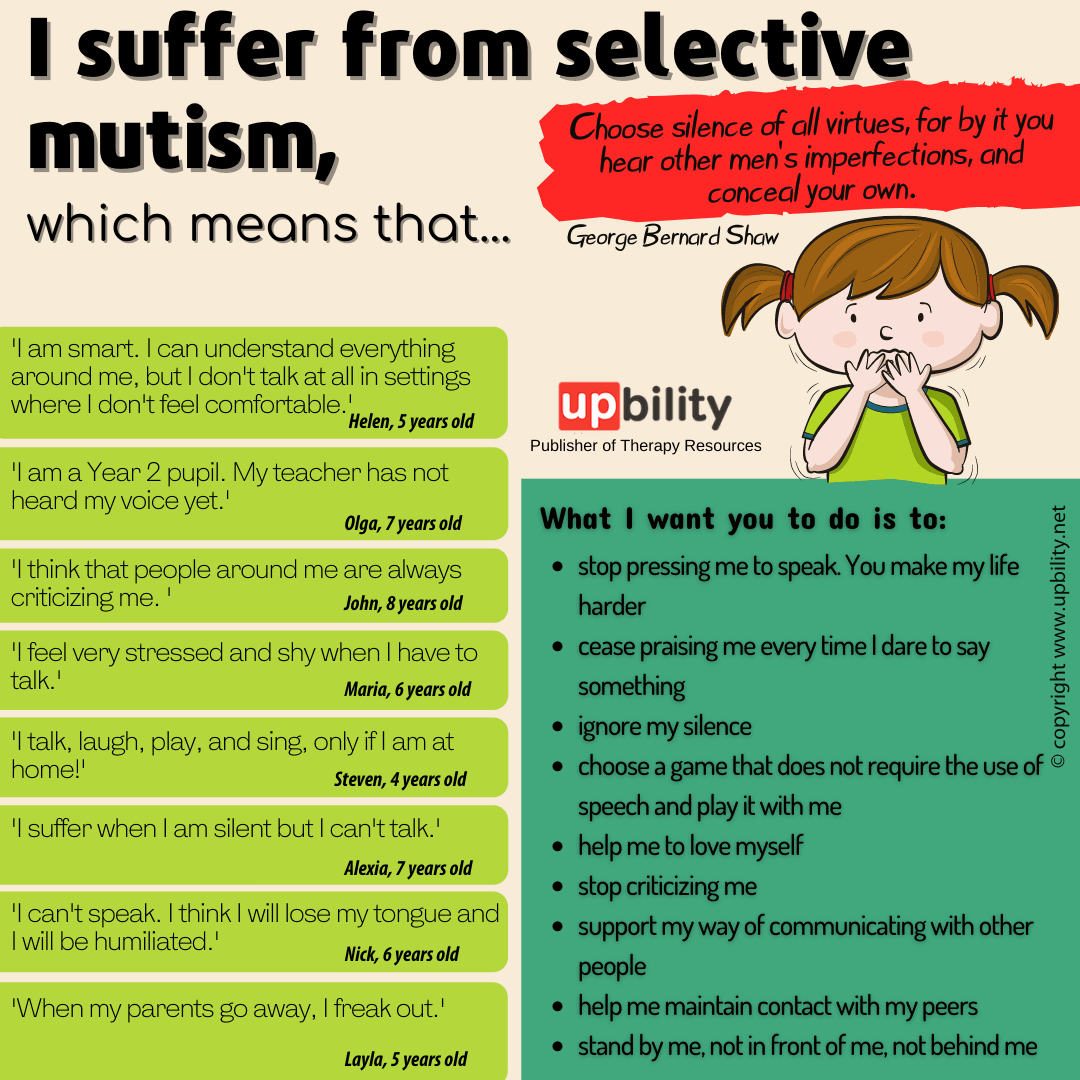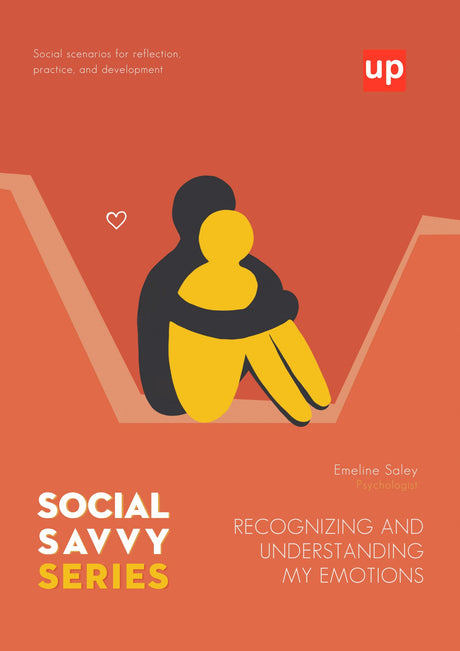Selective Mutism: What It Is and What It Means for Kids by Upbility
What Is Selective Mutism?
Selective mutism is the inability to talk in social settings despite being able to talk normally in a comfortable setting. Most often, this happens when children begin going to school. They may have normal speaking habits at home, but they cannot interact with their teachers and classmates when they get to school. The level of communication your child can perform will depend on the severity and particular symptoms of their selective mutism.
It is categorized as an anxiety disorder that generally starts during early childhood and can persist into adulthood if left untreated. This said, like other anxiety disorders, treating selective mutism can be challenging and requires patience, support, and, often, therapy.
Signs of Selective Mutism
As mentioned above, selective mutism often starts in early childhood and is first noticed when a child begins interacting with individuals outside their family. The biggest warning sign of selective mutism is the difference in the ability to interact and engage with unfamiliar people. This is often illustrated by sudden stillness or frozen facial expressions.
Some things you may notice if your child is suffering from selective mutism are:
- Avoiding eye contact with people, they are not comfortable with.
- Seeming shy and withdrawn.
- Seeming disinterested, sulky, or even rude.
- Appearing nervous or uneasy around groups of people they do not know.
- Stiff or tense posture.
- Exhibiting poor coordination in areas with more people or people they do not know.
- Seeming stubborn or upset, getting angry when asked questions by parents, or throwing temper tantrums when they get home from school.
Common Myths of Selective Mutism
Like with many other types of anxiety disorders, there are many myths or misconceptions about selective mutism that can harm individuals who suffer from it — especially if they are children. When it comes to myths about selective mutism, there are four big ones. These are as follows.
- Selective mutism is rare. In reality, selective mutism is not as rare as many people (including health professionals and researchers) think. This belief has led to many missed early diagnoses.
- The child is “choosing” not to speak. Selective mutism is an anxiety disorder, not a behavioral disorder. They are not choosing not to speak or being stubborn.
- It is just “shyness.” The big difference between selective mutism and shyness is that shy children still function in social settings. Children who suffer from selective mutism, however, do not. Instead, they freeze up.
- It is connected to autism. There is no recorded connection or correlation between selective mutism and autism. Your child may, however, have both. But, just because they have one does not mean they are at “higher risk” for the other.
What Causes Selective Mutism?
Selective mutism, like many other anxiety disorders, can result from many different causes or be difficult to trace back to a single cause. It is, however, known to be associated with anxiety. For example, when children become separated from their families (like when they are going to school), they may become anxious, and that anxiety may come out as selective mutism. Additionally, suppose your child has a speech impediment, language difficulties, or is unfamiliar with the language being spoken around them. These cases can make a new situation even more stressful for them.
Additionally, some children may be prone to sensory overload, and being in a new environment with new people, new noises, and no familiarity may be too much for them. As a result, they may shut down in these situations and be unable to speak with others.
How Is Selective Mutism Diagnosed?
Diagnosing selective mutism early is the best way to help your child overcome it and prepare for a fulfilling life. If left untreated, selective mutism can continue into the teenage years and even adulthood, leading to low self-esteem, isolation, and social anxiety disorder.
So, how is selective mutism diagnosed? Selective mutism requires a professional diagnosis that you can get from a speech and language therapist. You can contact your doctor if you suspect your child may be suffering from selective mutism, and they should be able to refer you to a trusted therapist.
What Does Selective Mutism Look Like for Kids
Depending on the severity of the selective mutism, your child may exhibit different symptoms. For example, in severe cases, your child may be unable to communicate in any way (whether written, spoken, or gestured) with people outside their comfort zone. On the other hand, a child with a less severe form of selective mutism may be able to offer simple gestures to answer questions or, in some cases, even offer short responses.
Remember, and explain to other adults who may be put off by these behaviors (such as teachers looking to get kids working together socially), that selective mutism is not a choice. Your child is not being stubborn; they are simply unable to speak in certain settings.
Your child may feel like they are being criticized by others when they speak because of a stutter or other part of their speech that they may be uncomfortable with. They may worry that they will mess up when they talk, and people will laugh at them. Even if they do not have any trouble talking at home, your child may feel stressed or frozen in settings in which they are not comfortable.
What Should You Do When Interacting with Someone Who Has Selective Mutism?
While treating selective mutism is essential to ensure that your child does not develop other severe anxiety disorders later in life, it is important not to push your child too hard. This can cause greater anxiety and delay their progress.
So, rather than pushing them to constantly get over their selective mutism, try to follow these guidelines for interacting with a child who suffers from selective mutism.
- Ignore their silence, do not constantly prompt them to speak.
- Pick games that do not require speech to play.
- Help them to love themselves.
- Support the ways that they do communicate with others.
- Do not praise them every time they say something — it can make them feel self-conscious that they are always being listened to, maybe more than others.
- Help them to maintain contact with their peers, but do not push them to speak.
- Do not criticize them, especially if they misspeak or slip up some words.
If you are a teacher looking to communicate better with your students suffering from selective mutism, check out this fact sheet from John Hopkins Medicine.
Conclusion
Whether you are a parent, a teacher, or any other person who interacts with a child with selective mutism, these tips should help you communicate more effectively and foster better connections with these children. Remember, selective mutism is not the result of the child being difficult or stubborn. Instead, it is an anxiety disorder that can also be extremely frustrating for the child.
So, if you take just one thing away from this article, remember to be supportive and gentle with children suffering from selective mutism.
copyright Upbility 2022
You can also read:
- What Is Oppositional Defiant Disorder?
- Tourette’s Syndrome: What Is It and What It Means for Kids
- Reducing Sensory Sensitivities
- Use Calm Voices to Calm Kids
- Are Autistic Girls Overlooked?
- ADHD and Lying: The Reasons Why Kids With ADHD Are Prone to Lying
- ADHD and Substance Abuse in Teenagers A Research
Suggested Books on Communication:
- LANGUAGE PROCESSING SKILLS | Enhancing Comprehension
- PICTURE CARDS | Expressive Language: Getting it Right!
- Developing graphophonological awareness
- PROCESSING SPEED | Improving Performance Strategies
Suggested Books on Language:
- Developing Reading Comprehension in Children with Autism Spectrum Disorder - PART 1
- Building Descriptive Skills Step-by-Step – Age: 4+
- Development of Oral and Written Discourse through Argumentation
Suggested Books on Behavior management:
Get more free poster:
- Inner Child Traumas
- I suffer from obsessive-compulsive personality disorder
- I suffer from depression
- I have Dyslexia
- EMOTIONAL EQUATIONS










